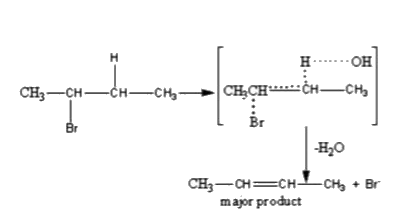Which of the following applies in the reaction,
(i) (major product)
(ii) (minor product)
A
Markownikoff's rule
B
Saytzeff's rule
C
Kharasch effect
D
Hofmann's rule
Text Solution
The correct Answer is:B
Alkyl halides on heating with alcoholic KOH give dehydrohalogenation reaction to yield alkene. If in reaction, more than one alkenes are formed, then according to Saytzeff, the most highly substituted alkene is the major product.

|
Topper's Solved these Questions
Similar Questions
Knowledge Check
Which of the following applies in the reaction,
CH3CHBrCH2CH3alc.KOH−−−−−→
(i) CH3CH=CHCH3 (major product)
(ii) CH2=CHCH2CH3 (minor product)AMarkonikoff's ruleBSaytzeff's ruleCKharasch effectDHofmann's ruleIn the given reaction CH3CH2CH≡CHCH3X−−→CH3CH2COOH+CH3COOH
The X isAC2H5ONaBConc. HCl+AnhyZnCl2CAnh. AlCl3DKMnO4/OH−Predict the product of the reaction
(CH3)2CHCHClCH2CH3+KOHalc−−→A(CH3)C=CHCH2CH2CH3B(CH3)2CHCH=CHCH2CH3C(CH3)2CHCH=C(CH3)CH2CH3D(CH3)2C=CHCCH3=CH2
The major product formed in the following reaction is :
CH3CH=CHCH(CH3)2HBr−−→
View SolutionThe reaction
CH3CHBrCH3+KOHalc−−→CH2=CH−CH3+KBr+H2O is an example of
View SolutionThe reaction CH2=CHCH3=HBr→CH3CHBrCH3 is-
View SolutionThe compounds CH3CH=CHCH3 and CH3CH2CH=CH2
View SolutionWhich of the following alkanes can exhibit cis-trans isomerism?
(i) CH2=CHCH2CH3 , (ii) CH2=C(CH3)2
(iii) CH3CH=CHCH3 , (iv) CH3CH2CH=CHCl
View Solution
